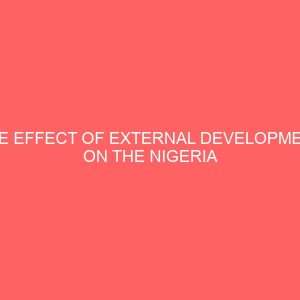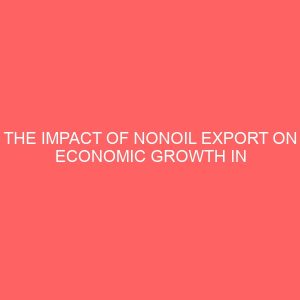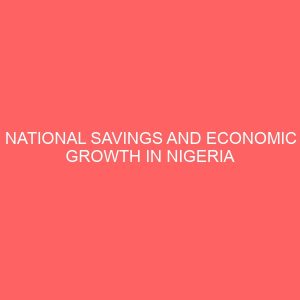Description
CHAPTER ONE
INTRODUCTION
1.1 BACKGROUND OF THE STUDY
The accumulation of external debt is a common phenomenon of the third World countries at the stage of economic growth and development where the supply of domestic savings is low, current account payment deficit is high and import of capital is needed to increase domestic resources.
The management of Nigeria’s external debt has been a major macroeconomic problem especially since the early 1980s. For many years now, the country’s debt has been growing in spite of the efforts being made by the Government to manage and minimize its crushing effects on the nations economy. Such efforts range from the various refinancing and restructuring agreements to debt conversion programme and the deliberate allocation of substantial resources towards servicing the debt. Of particular concern to the authorities, is the heavy debt burden it imposes when compared with the country’s debt service capacity.
In recent years, however, some observers have held different perceptions about Nigeria’s capacity or otherwise to service her debt. This is largely because of the improved income to the country arising from export of crude oil, Nigeria’s major export. Moreover others have argued that bad governance, especially during the military rule, largely accounted for the mismanagement of the Nigerian economy and therefore, the people should bear the brunt. Whatever position one holds, what appears undisputable is the increasingly large debt service requirement which imposes considerable stress on the Nigerian economy even when the improved resource inflow is factored into the country’s cash flows. Indeed, the issue of sustainability of Nigeria’s debt profile continued to be the focus of research and public debate until the recent initiative of the Paris Club of Creditors which appears to address the issue in a more meaningful way.
Even then the conditions and adequacy of the debt relief have continued to generate further debate.
The objective of this paper is to review Nigeria’s external debt and the burden it imposes, and use the various indicators and prevailing global economic circumstances to justify the need for substantial debt relief for the country.
However, during the late 70s and early 80s, commercial banks began playing a big role in international lending by recycling surplus OPEC petrodollars and issuing general purpose loans to less developed countries to provide balance of payment support and expansion of export sectors. While foreign borrowing can be highly beneficial providing the resources necessary to promote economic growth and development, it has its cost. In recent years, these costs have greatly outweighed the benefits for many developing nations. The main cost associated with the accumulation of a large external debt is debt serving.
Debt servicing is the payment of liquidation of the principal and accumulated interest. It is a contractually fixed exchange on domestic real income and savings as the debt grows or as interest rate raise. Debt service payment must be made with foreign exchange. In other words, debt service obligation can be met only through export earnings.
However, should the composition of import change or should the composition of export change or should interest rate rise causing ballooning of debt service payment or should export earnings diminish, debt servicing difficulties are likely to arise. This has been the experience of most of the heavily indebted third World nations.
In order to solve the problem, several external debt financing options were adopted under the Structural Adjustment Programme SAP in 1986. Since the introduction of this programme, Nigerians have been plunged into one hardship after another ranging from the devaluation of the naira through Second Tie Foreign Exchange Market SFEM now Foreign Exchange Market FEM to the rising prices of commodities, inflation etc. SAP as an economic restructuring program is capable of alleviating the countrys debt trap, a miracle Nigerians are waiting to see.
Specifically, as part of the programmatic approach to reduce the burden of external debt, embargo on new loans, limit on debt service payment, debt restricting and debt conversion have been adopted in recent years.
1.2 STATEMENT OF THE PROBLEM
The aim of any well coordinates and articulated economic policy is to achieve a sustained economic growth and development. However, a proper understanding of what development is will enable a policy maker to formulate appropriate policies for the acceleration of economic growth. In other words, the nature of the development policy of a country will depend on how policy makers of the country perceive growth.
The insistence of the need of external assistance obscures the necessity for the people of poor countries themselves to develop the facilities, attitudes and institutions which are required if these societies are to achieve sustained substantial material process. Indeed, these insistence are external aids to help perpetuate the ideas and attitude widespread in these countries which are changing the economic progress.
The rapid growing foreign debt, its consequent payment problem and lack of appropriate debt management has plummeted the country into a turbulent economic crisis, balance of payment problem, foreign exchange sequence scarcity of essential items including raw materials and spare parts which led to the closure of many factories, retrenchment of workers, high rate of unemployment and underemployment. Embarking on productive ventures for instance led to waste of resources and of course, poor economic performance.
1.3 OBJECTIVE OF THE STUDY.
The objectives of the study include:
I To determine the relationship between external debt and economic growth in Nigeria.
II To determine the impact of external debt on the economic growth in Nigeria.
III To examine the size and trend of external debt on the economic growth in Nigeria.
1.4 RESEARCH HYPOTHESIS
I H0: There is no relationship between external debt and economic growth in Nigeria.
ii H0: There is no impact of external debt on economic growth in Nigeria.
iii H0: External debt has no trend and size on the economic growth in Nigeria.
1.5 SIGNIFICANCE OF THE STUDY.
The significance of the study has to do with the impacts or effects of the study on the people. Therefore, the significance of this study seeks to highlight on the following factors:
I The study serves as a guide for future governmental policy on debt minimization and control.
ii Also the study will bring to notice on the entire citizens the impact of the external debt on the welfare and living standard.
1.6 SCOPE OF THE STUDY
The project covers the structures of Nigeria’s external debt, its management techniques and some factors that contributed to the huge debt. The time frame of this project is 19892009 was chosen because it allows an analysis of the Structural Adjustment Programme SAP which was at this period, partly solve the debt crisis and partly foster sustainable economic growth.
1.7 LIMITATIONS OF THE STUDY
This study is basically restricted to the effect of external debt on the Nigeria economy growth. The research was not able to gather all the necessary materials from all the secondary sources needed for the study due to unforeseen circumstances resulting from time and financial constraints.








Reviews
There are no reviews yet.